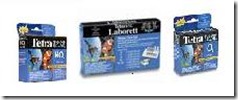Water quality testing is important, especially when you are starting a new fish pond or filter. This is the time when the bacteria in the biological filter is trying to grow and establish itself and ammonia, nitrite will be present in the initial stage of nitrogen cycle. During this time, risk of fish fatality is high and pond keepers will not risk putting in expensive, show grade Koi until there is no ammonia or nitrite present, as determined by the water quality testing. Instead, most pond keepers will put in small feeder fish or low grade Koi to produce the needed fish waste to feed and cultivate the bacteria in the filter. It normally takes a few weeks for the biological filter to establish itself.
Other times when water testing should be done is when you have recently added more fish to your pond. This is the time when the water parameters will deviate from the norm as the filter adjust to the new load of waste matters coming from the increased population.
I am using the Tetrapond Laborett test kit. It tests pH, carbonate and general hardness, nitrite, ammonia and carbon dioxide. I also use the individual test kits for oxygen level and nitrate.
pH is a measure of the acidic or basic (alkaline) nature of a solution. Normal tap water or fresh water should have pH level of 7. Water with a lower pH level is deemed acidic while alkaline water would have higher pH. Chalk, limestone, coral or seashells dissolved in water will produce higher pH. pH level is usually determined by your water supply. Koi requires a pH slightly above 7. The best way to control pH is to include crushed coral ships or seashells as one of your filter media. The carbonate in them will acts as a buffer against sudden, sharp drop in pH level which kills fish swiftly.
Oxygen level testing is important to determine if you have enough aeration in your pond to support the fish and plant population in your pond. I do this at the onset of a new pond or when I add more fish to my pond. Once you have the right level of aeration, the oxygen level seldom fluctuates a lot unless you have a broken pump. I actually notice small bubbles forming at the sides of my pond when sunlight is shining on the algae that grows on the side. I think this is a good sign of oxygen level saturation and my aeration level is sufficient.
Nitrate is an output of your biological filter. Nitrate is harmless to fish in small quantities but as mentioned in my earlier post on the need for regular partial water change, nitrate level should be kept low. When the nitrate level goes beyond the level indicated in the test kit, it means it is time for partial water change. I actually stop doing my nitrate level testing and just do my regular partial water change as a routine. Other symptoms of excessive nitrates will be excessive algae growth (greenish water) or brownish tint in the water.
In the beginning of my Koi hobby, I used to test regularly and log down the readings in my excel spreadsheet. As I get more experience in pond and koi keeping, I actually stop performing water quality testing although I still have my water testing kit on standby. Maybe this is not a good trait of a good koi keeper but then, that’s me. I stick to my regular partial water change routine, regular filter maintenance and I know that my pond and filter is well designed to produce good water quality. I observe my Koi’s behaviour daily during feeding. My water test kits will be used immediately when I notice my Koi behaviour changes. So far, so good!

No comments:
Post a Comment